Did you know that, on average, people have stronger pushing muscles than pulling muscles?
Table of Contents
ToggleAccording to the study conducted by Negrete RJ, Hanney WJ, Pabian P, and Kolber MJ found on the website of the National Library of Medicine, the results indicate that the males had a push-up to modified pull-up ratio of 1.57:1, and females had a ratio of 2.72:1 [1].
The study clearly suggests that the upper body pushing muscles are between 1.5 and 2.7 times stronger than those used for pulling activities.
The reason I mentioned this is that there is a very simple way to correct those muscle imbalances and recover your functionality.
The secret lies in performing a well-programmed pull day workout plan, and that’s the topic of today’s article.
As a Faculty of Sport and Physical Education student, I have conducted a 54-hour research to compile the best pull workouts and exercises to correct muscle imbalances and improve your overall performance.
Keep reading below to learn about all the details regarding this effective pull day routine.
Start Building Your Dream Body Today
Ready to elevate your fitness game without falling into the trap of dull, repetitive routines that just don’t deliver? Imagine sculpting your ideal physique and boosting your health, all while still enjoying life’s pleasures, like those irresistible weekend getaways and your aunt’s legendary cheesecake. With our online fitness and nutrition coaching service, you don’t have to compromise. Dive into a personalized fitness journey that blends perfectly with your lifestyle, not against it. Book your completely free discovery consultation today, and take the first step towards a transformation that doesn’t require giving up the joys of life.

“I was skeptical about online fitness coaching, but Functional Body Savage completely changed my perspective. Vanja and Radomir’s personalized approach and attention to detail have helped me achieve goals I never thought possible. I’m stronger, more confident, and grateful for their guidance.”
Emily Thompson, San Francisco, CA
Learn More About Our Online Coaching ServiceQuick Summary
- The pull-day workout routine should include exercises such as traditional barbell deadlifts, barbell bent-over rows, bodyweight pull-ups, bilateral dumbbell rows, face pulls, barbell curls, and preacher curls.
- A pull-day workout routine is the type of workout consisting of pulling exercises primarily targeting your back and bicep muscles by following the vertical, diagonal, or horizontal movement pattern.
- To make progress in terms of strength and hypertrophy, you must always incorporate the principle of progressive overload in every subsequent workout routine.
The Pull Day Workout Routine
Below, I made sure to include all the best pull day exercises that should be incorporated into the pull day workout plan.
I will explain each exercise briefly, give clear instructions on how to perform them with the correct form, and then we will jump into programming the perfect pull workout.
Let’s start with the traditional barbell deadlift first.
Traditional Barbell Deadlifts
A traditional barbell deadlift is one of the best pull day exercises, primarily involving hip hinging. For that reason, some functional training experts also put it below the hip hinge or bending movement pattern. I consider barbell deadlifts to be a little bit of both.
Barbell deadlifts will effectively strengthen your posterior chain muscles, such as biceps brachii, semitendinosus, semimembranosus, glutes, and erector spinae. Also, some additional muscles, such as lats, traps, and core muscles, will either serve as synergists or stabilizer muscles during the barbell deadlift movement.
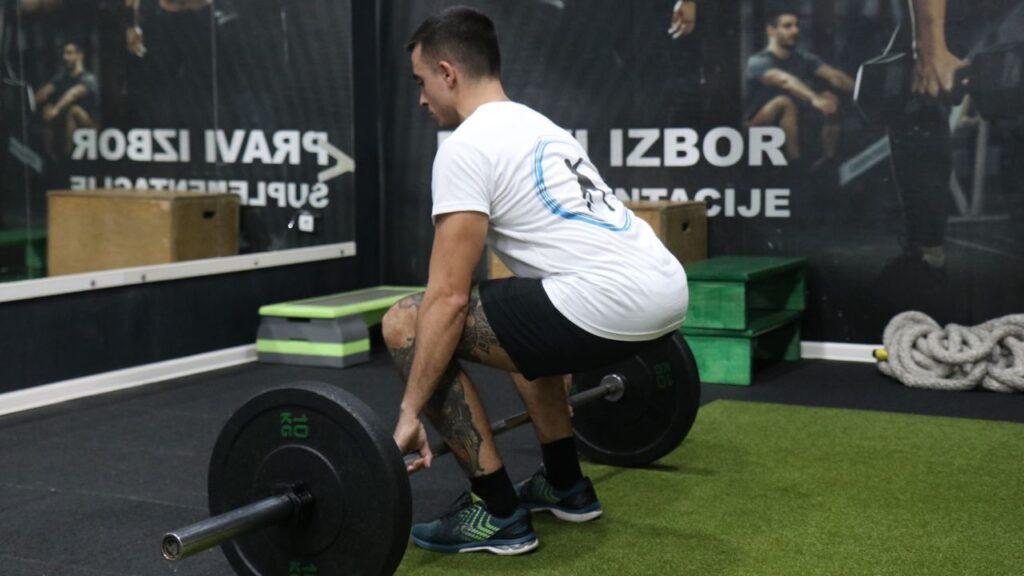
How to Perform a Traditional Barbell Deadlift
- Place the barbell on the floor and load it with weight plates according to your current fitness level. I usually suggest picking the weight that you can perform at least 6 reps with after you conduct the proper warm-up, of course.
- Assume a standing position hip-width apart in front of the barbell and let your shins almost touch the bar.
- Take a pronated or combined grip shoulder-width apart.
- Bend in your hips, knees, and ankles to enter the starting position of the exercise. Make sure your hips and back are flat, meaning they are placed in the neutral position.
- Your head should be in line with your spine, and your eyes should look straight ahead of you.
- Pull the bar towards the ceiling. Simultaneously extend your ankles, knees, and hips while pulling the barbell upwards and close to your body.
- When your knees are almost fully locked, hips neutral, back flat, and barbell in the highest pulling position, hold it for one second.
- Reverse the motion by putting the barbell back on the floor and repeating the whole process again.
Pro Tip: Engage your core and maintain a flat back throughout the lift to protect your spine; drive the movement from your hips and heels, not your back, to maximize leg and glute engagement.
Barbell Bent-Over Rows
Barbell bent over rows is one of my personal favorite pull day exercises for two reasons. First, they are excellent for improving your overall back muscle strength. Second, they can be used as a corrective exercise for people with a bad pushing-to-pulling ratio.
One of the studies titled “Comparison of different rowing exercises” found on the National Center for Biotechnology Information website suggests that the standing bent-over row elicits large muscle activation symmetrically from the upper to lower back [2]. This makes it an ideal exercise for developing foundational strength for the entire back musculature.
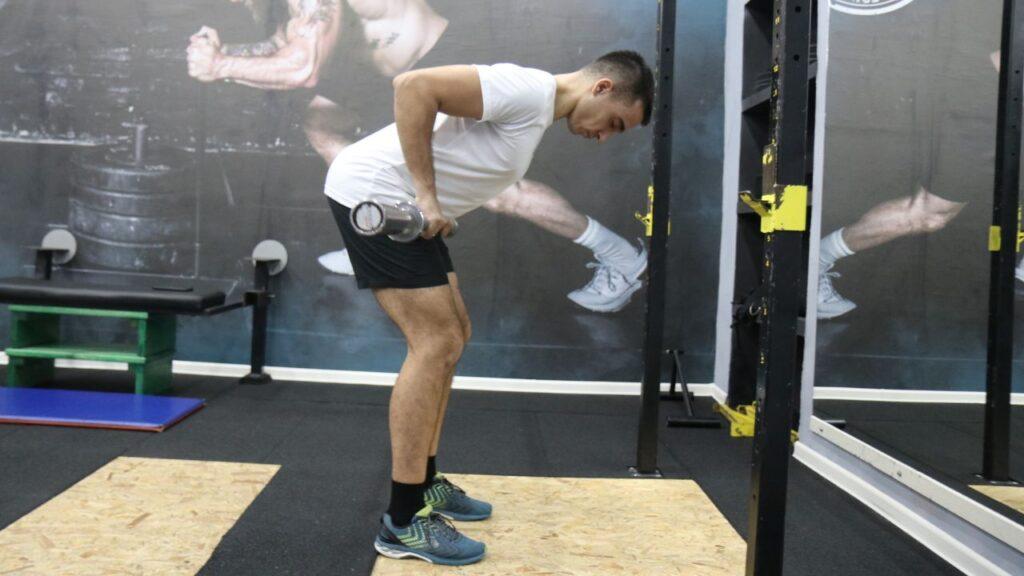
How to Perform Barbell Bent-Over Rows
- Place the barbell on the rack about the height of your hips and load it with weight plates so you can perform at least 8 reps with it.
- Take the pronated grip between hip and shoulder-width apart, unrack the barbell, and take a step back.
- Bend forward in your hips, slightly flex your knees, and keep them in that position during the entire exercise.
- Try to position your body so it is almost parallel to the floor.
- Your feet should be hip-width apart, and your toes should look straight ahead.
- Start the exercise by pulling the barbell towards your stomach and hip area.
- You do this by extending your shoulders and bending your elbows.
- When the barbell almost touches your stomach, hold that position for one second.
- Reverse the motion to return to the starting position and repeat.
Pro Tip: Initiate the row by retracting your shoulder blades first, creating a ‘pinching’ sensation between them; this ensures scapular movement and engagement, which is crucial for shoulder health and proper activation of the upper back muscles.
Bodyweight Pull-Ups
Pull-ups belong to the vertical pulling pattern and are one of the best pulling exercises for strengthening your back muscles. They are excellent at targeting your lats. Most people don’t know this, but pull-ups actually also activate your pectoral muscles, which sounds contradictory because chest muscles are mainly activated during pushing exercises.
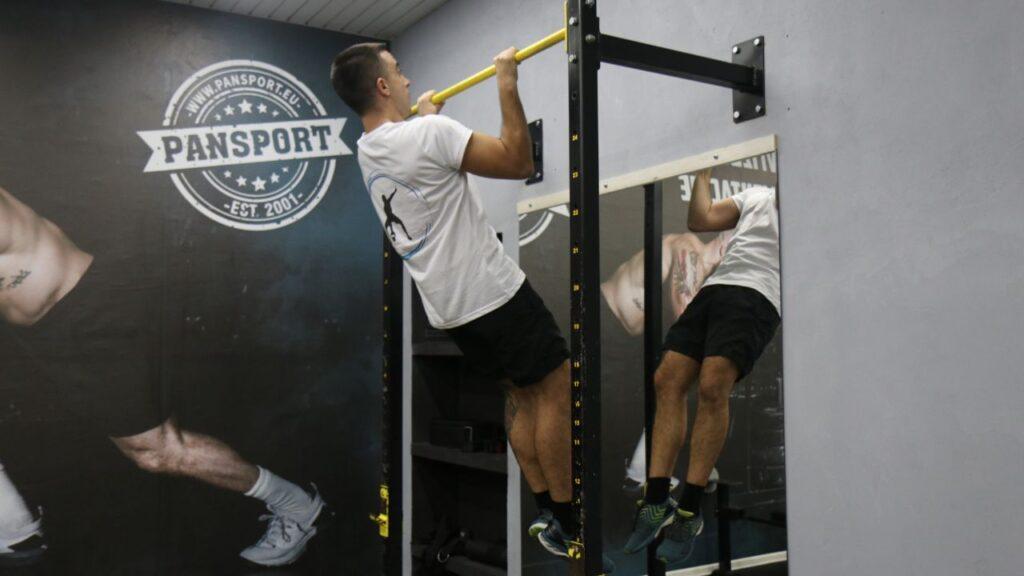
How to Perform Pull-Ups
- Grip the pull-up bar a little wider than the shoulder width apart. Take the pronated grip.
- Hang from the bar.
- Start the exercise by pulling yourself towards the bar, aiming to place your chin above it.
- When your chin reaches the position above the bar, hold it for one second.
- Slowly lower your body towards the starting position by extending your elbows and abducting your shoulders.
- Repeat the whole process again for the next rep.
Pro Tip: Before initiating the pull-up, draw your shoulder blades down and back to set your shoulders in a stable position; this not only engages the correct muscles but also protects your shoulder joints. Focus on “pulling with your elbows” rather than your hands to activate your lats better and achieve a more powerful and efficient movement.
Expert Explains the Importance of Incorporating Pull-Ups into Your Routine
In a YouTube video, Jeff Nippard, a pro natural bodybuilder, powerlifter, and science communicator to over 2 million YouTube subscribers, provides valuable insights on the significance of pull-ups for enhancing your pull day workout routine:
“Now normally on a pull day I do multiple sets for pull-ups, however, since we already smashed our lats on the cables I figured we’d just do one all-out set here. Also, I found that while calisthenic enthusiasts love pull-ups, a lot of bodybuilders don’t seem to like them as much. And while I do think it’s important that your training is enjoyable, I also think pull-ups are a great exercise worth including that you shouldn’t avoid just because they’re harder than lat pull-downs. So here’s my compromise: you only have to do one set, but it has to be all-out. I think that’s fair. So as an AMRAP set each week, you should try to at least match or ideally beat the number of reps you got the week before while maintaining the same consistent form.”
Bilateral Dumbbell Rows
Bilateral dumbbell rows are a staple in any good pull day workout. They effectively target your lats, traps, rhomboids, and back deltoid muscles, essential for developing holistic back strength.
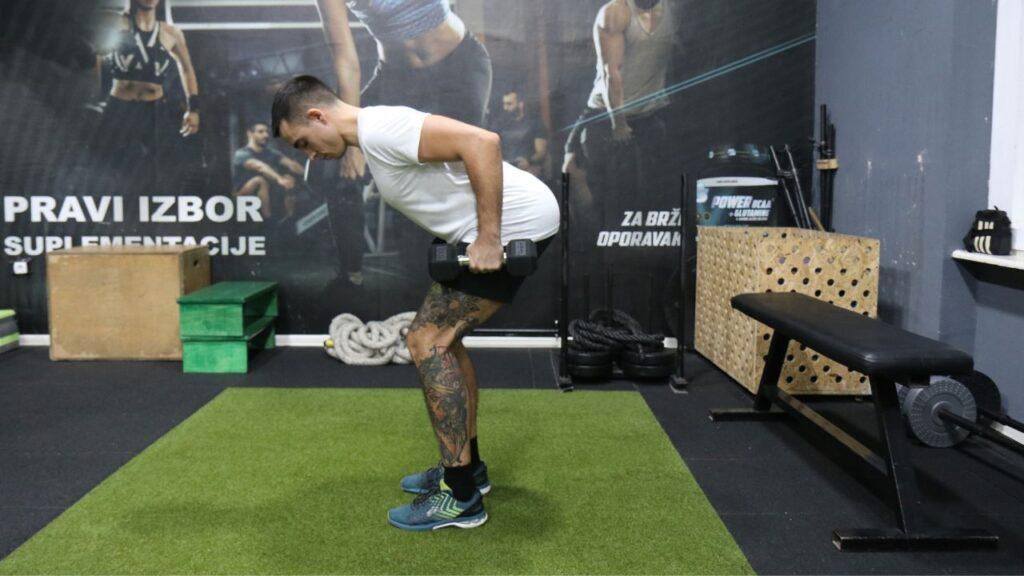
How to Perform Bilateral Dumbbell Rows
- Pick two dumbbells and assume a standing position with your feet hip-width apart.
- Hold the dumbbell in each hand.
- Stand with your feet hip-width apart.
- Keep your knees slightly bent throughout the entire movement.
- Bend in your hips so your trunk becomes parallel to the floor.
- Keep your back straight during the entire movement to avoid injuries.
- Start the exercise by rowing the dumbbells towards your stomach. This is done by flexing your elbows and extending your shoulders.
- When the dumbbells reach the level of your stomach or hips, depending on your rowing trajectory, hold that position for one second.
- Reverse the movement to return to the starting position and repeat.
Pro Tip: Squeeze your dumbbells at the end range of motion to add that little extra bonus of muscle contraction to your workout.
Face Pulls
Face pulls are usually used in rehabilitation or corrective exercise program scenarios. They are excellent at improving your overall posture and strengthening those weak pull day muscles located on your back.
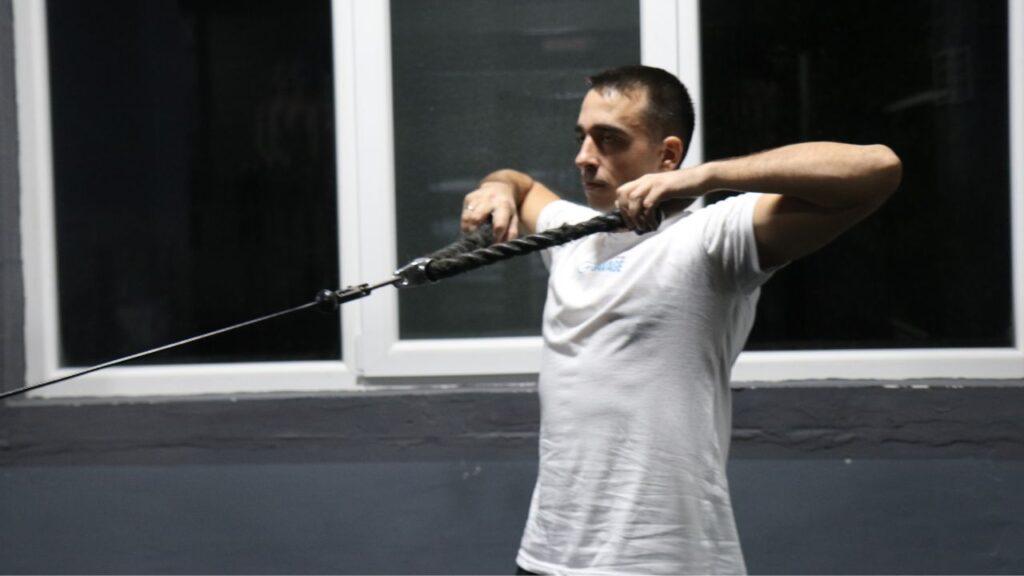
How to Perform Face Pulls
- Attach the rope attachment to the cable machine. Make sure it is above the level of your shoulders.
- Grasp both ends of the rope and take a step back.
- Assume feet shoulder width apart stance.
- Pull the rope towards your face by bending your elbows and horizontally abducting your shoulders.
- When you reach maximal horizontal abduction in your shoulders, hold that position for one second.
- Reverse the motion to return to the starting position and repeat the whole process again.
Pro Tip: When performing face pulls, concentrate on the movement of your shoulder blades; retract and squeeze them together as you pull the rope toward your face. This not only engages the targeted upper back muscles, including your rear deltoids and rhomboids but also enhances postural benefits and shoulder health.
Barbell Curls
Barbell curls are excellent for developing your arm muscles, such as biceps brachii, coracobrachialis, brachioradialis, and brachialis. Barbell curls represent a staple pulling exercise used for decades to develop your biceps, or as some people might call it, the guns.
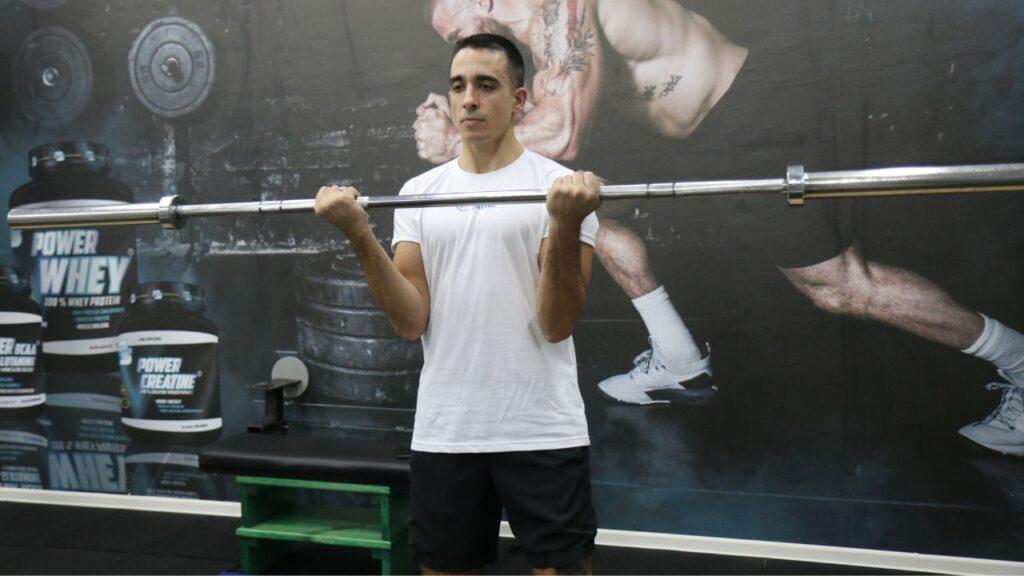
How to Perform Barbell Curls
- Place the barbell on the rack about the height of your hips and load it with adequate weight plates so you can perform around 10 reps without pausing.
- Take a supinated grip around shoulder width apart, unrack the barbell, let it hang from your hands free, and step back to have enough space to perform the exercise.
- Start the exercise by curling the barbell towards your shoulders by bending your elbows and keeping shoulder shoulders joints fixed.
- When the barbell reaches maximal flexion, or the so-called top position/end range of motion, reverse the movement to return to the starting position.
- Repeat for the desired number of reps.
Pro Tip: To maximize the effectiveness of barbell biceps curls, keep your elbows stationary and close to your torso throughout the entire movement. This isolates the biceps muscles and prevents momentum from taking over, ensuring that your biceps are doing the work, not your shoulders or back.
Preacher Curls
Preachers curl is the last pulling exercise on our list that is also used for upper arm development, specifically for the biceps.
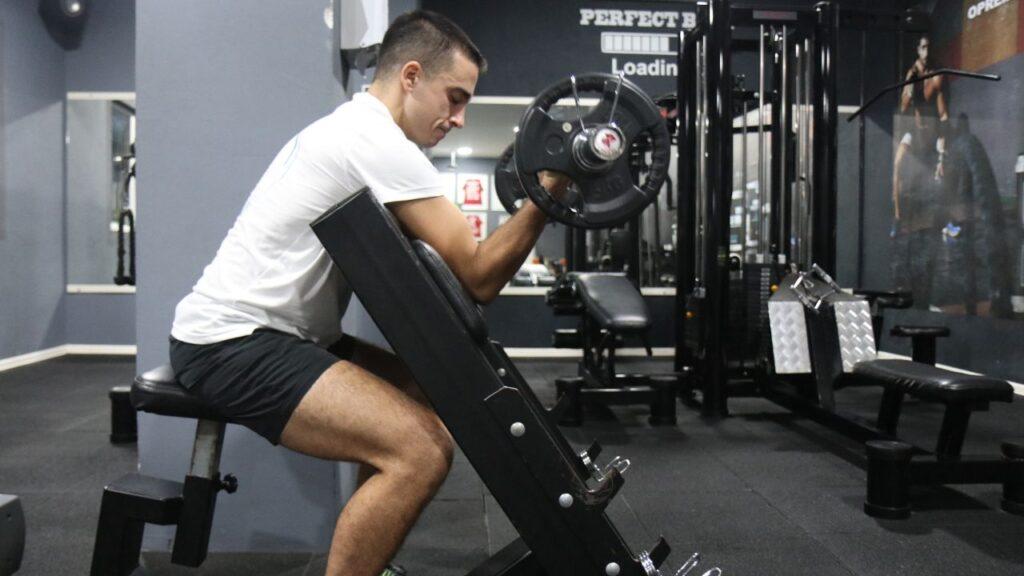
How to Perform Preacher Curls
- Place the Z-bar on the preacher curl machine and load it with sufficient weight.
- Assume a sitting position on the machine and take the supinated grip, but don’t yet unrack the bar.
- After you assume a stable position and a firm grip, adjust your grip width to suit your personal preferences.
- Start the exercise by curling the bar towards your shoulders by flexing your elbows and keeping your shoulders fixed.
- When you reach the top position, maximal elbow flexion, hold it for one second.
- Reverse the motion by extending your elbows to return the bar to the starting position.
- Repeat for the desired number of reps.
Pro Tip: To maximize the effectiveness of preacher curls, ensure your elbows are snugly positioned against the pad without any gap, as this stabilizes your arms and isolates the biceps. Additionally, focus on a controlled movement, especially on the eccentric phase (lowering the weight), to increase muscle tension and promote growth.
Programming the Perfect Pull Workout
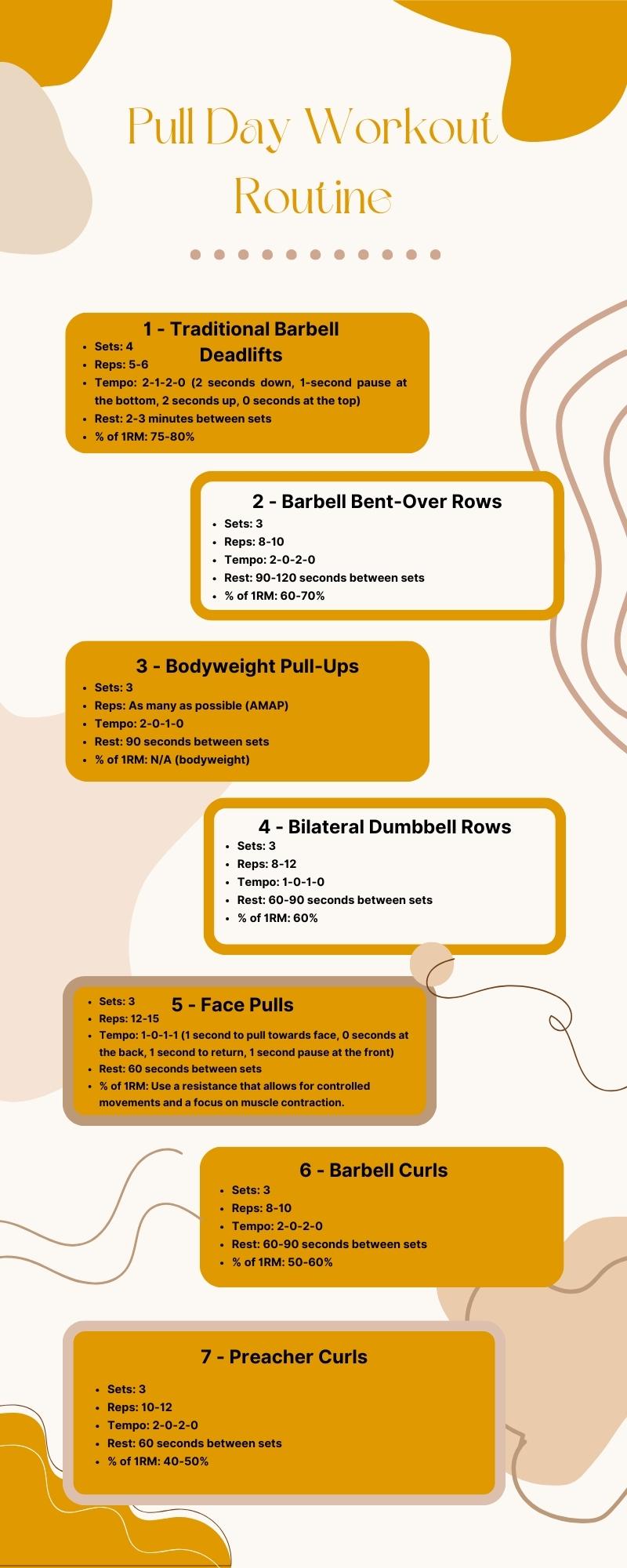
Traditional Barbell Deadlifts
- Sets: 4
- Reps: 5-6
- Tempo: 2-1-2-0 (2 seconds down, 1-second pause at the bottom, 2 seconds up, 0 seconds at the top)
- Rest: 2-3 minutes between sets
- % of 1RM: 75-80%
Barbell Bent-Over Rows
- Sets: 3
- Reps: 8-10
- Tempo: 2-0-2-0
- Rest: 90-120 seconds between sets
- % of 1RM: 60-70%
Bodyweight Pull-Ups
- Sets: 3
- Reps: As many as possible (AMAP)
- Tempo: 2-0-1-0
- Rest: 90 seconds between sets
- % of 1RM: N/A (bodyweight)
Bilateral Dumbbell Rows
- Sets: 3
- Reps: 8-12
- Tempo: 1-0-1-0
- Rest: 60-90 seconds between sets
- % of 1RM: 60%
Face Pulls
- Sets: 3
- Reps: 12-15
- Tempo: 1-0-1-1 (1 second to pull towards face, 0 seconds at the back, 1 second to return, 1 second pause at the front)
- Rest: 60 seconds between sets
- % of 1RM: Use a resistance that allows for controlled movements and a focus on muscle contraction.
Barbell Curls
- Sets: 3
- Reps: 8-10
- Tempo: 2-0-2-0
- Rest: 60-90 seconds between sets
- % of 1RM: 50-60%
Preacher Curls
- Sets: 3
- Reps: 10-12
- Tempo: 2-0-2-0
- Rest: 60 seconds between sets
- % of 1RM: 40-50%
What Is a Pull Day Workout?
A pull-day workout is a type of resistance training routine that focuses on exercises where you pull weight or resistance toward your body, primarily targeting the muscles of the back and biceps. Typical exercises on a pull day might include pull-ups, bent-over rows, lat pulldowns, single-arm lat pulldowns, and bicep curls, among others. Creating a pull day exercises list can help structure your workouts effectively.
The goal of a pull-day workout is to develop and strengthen the muscles involved in pulling movements, creating a balanced and well-rounded upper body.
What Muscles Are Targeted in a Pull Workout?
A pull workout is a fundamental component of any well-rounded strength training program, and it primarily targets the following muscle groups.
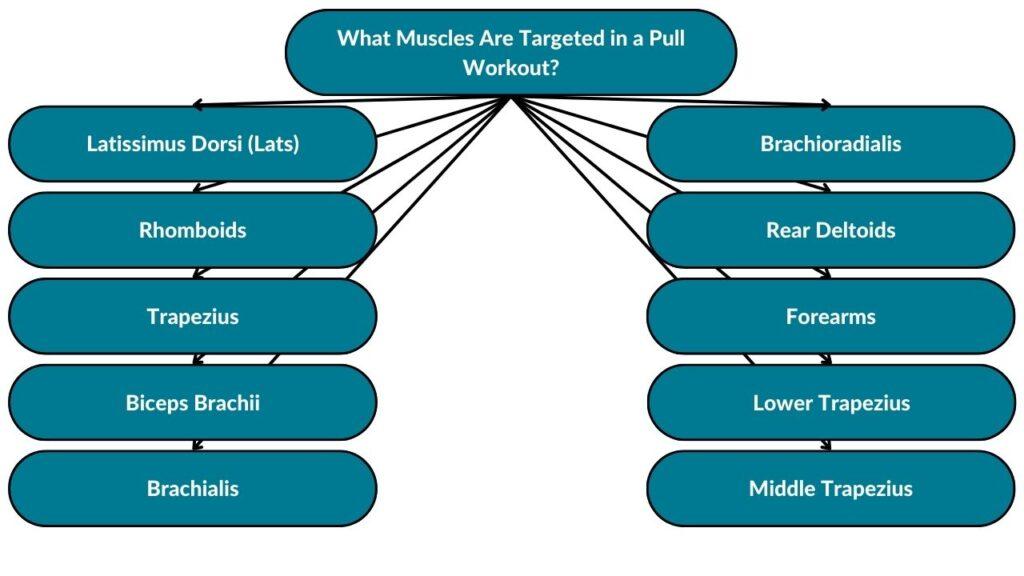
Latissimus Dorsi (Lats)
The lats are the broad muscles of the back, running from the armpits down to the lower back. Pull exercises effectively engage the lats, contributing to a wider and more defined back.
Rhomboids
Located between the shoulder blades, the rhomboids play a crucial role in scapular retraction, pulling the shoulder blades together, and maintaining proper posture.
Trapezius
The trapezius muscles, often referred to as “traps,” are divided into three sections – upper, middle, and lower. They assist in various functions, such as shoulder elevation, retraction, and depression.
Biceps Brachii
The biceps are the front upper arm muscles, and they are involved in curling and pulling motions during pull exercises.
Brachialis
Located beneath the biceps, the brachialis muscle is engaged during pull exercises, contributing to elbow flexion.
Brachioradialis
The brachioradialis muscle, located on the forearm, plays a role in forearm flexion and pronation and is involved in various pulling movements.
Rear Deltoids
The rear deltoids, or posterior deltoids, are the muscles at the back of the shoulders and are activated during exercises that involve shoulder extension and retraction.
Forearms
The forearm muscles are engaged during pull exercises, as they are responsible for gripping and holding weights or handles.
Lower Trapezius
The lower trapezius, located in the lower portion of the back, is essential for maintaining shoulder stability and proper posture.
Middle Trapezius
The middle trapezius, situated between the upper and lower portions of the trapezius, contributes to scapular retraction and shoulder blade control.
What Is the Principle of Progressive Overload?
The principle of progressive overload is a fundamental concept in strength training and fitness. It involves gradually increasing the intensity, resistance, or workload of an exercise over time to continually challenge and stimulate the muscles, leading to strength and muscle gains.
By progressively overloading the muscles, whether through increased weight, repetitions, or intensity, individuals can adapt and grow stronger, promoting consistent improvements in physical fitness. This principle is essential for avoiding plateaus and ensuring ongoing progress in strength and muscle development.
Interested in designing your own functional training routine? Check the article below:
Why Is Incorporating Progressive Overload for Your Pull Exercises Essential?
ncorporating progressive overload in your pull day program is essential for several reasons.
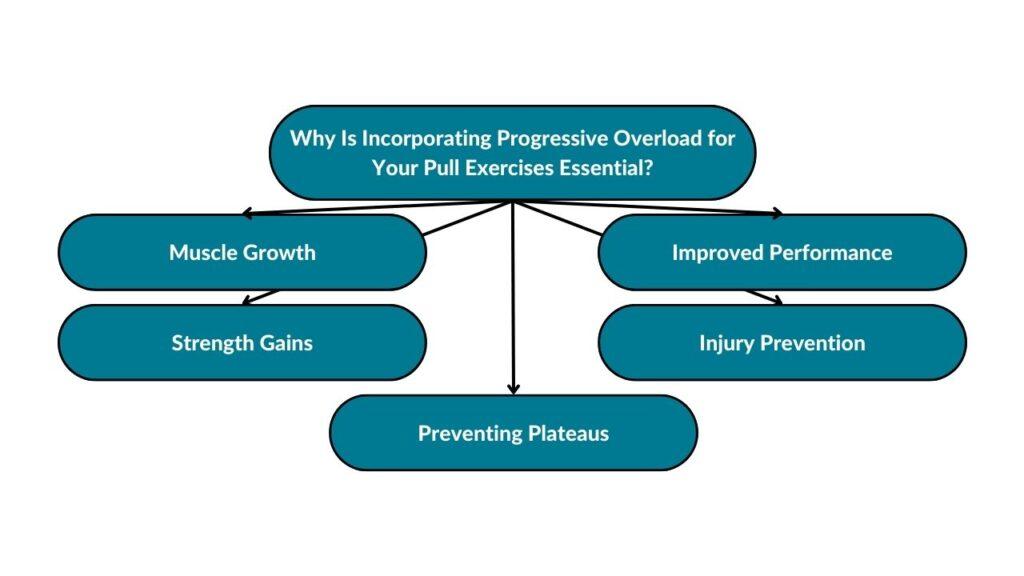
Muscle Growth
Progressive overload ensures that you continually challenge your muscles, leading to micro-tears and repair, which results in muscle growth. This is vital for achieving strength and aesthetic goals in your back, biceps, and other muscles involved in pulling movements.
Strength Gains
Increasing the resistance or intensity over time helps you build strength more effectively. By lifting progressively heavier weights or increasing the difficulty of pull exercises, you enhance your overall upper body strength.
Preventing Plateaus
Without progressive overload, your body may adapt to a certain exercise, leading to training plateaus where you cease making progress. Incorporating progressive overload methods keeps your pull day routine challenging and stimulating.
Injury Prevention
Gradually increasing the workload allows your muscles, tendons, and ligaments to adapt and become more resilient, reducing the risk of overuse injuries.
Improved Performance
Progressive overload enhances your ability to perform daily activities with ease, as well as sports or other physical pursuits. It contributes to functional strength and enhanced physical performance.
How to Make the Most Out of Your Pulling Exercises and Workout Routine?
Below are a couple of things I believe you should consider to make the most out of your pulling exercises and pull workout routine.
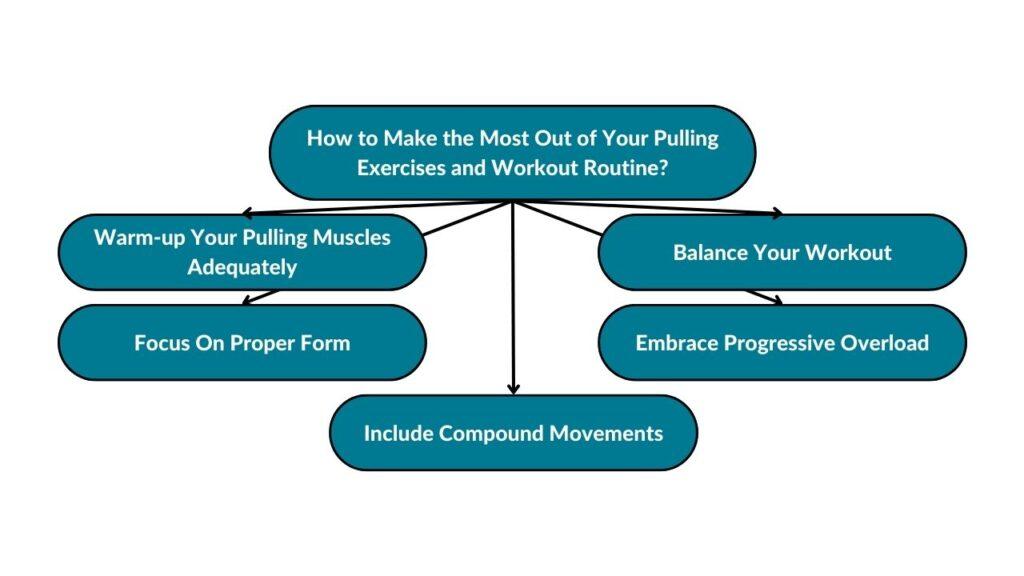
Warm-up Your Pulling Muscles Adequately
It’s crucial to warm up the muscles you are going to target before the main part of your workout starts. By warming up your muscles, I mean to elevate your core temperature by performing some type of light cardio activity such as jogging or rope jumping.
This will improve the elasticity of your muscles, prepare them for the upcoming workout, and lower the chance of potential injuries.
Focus On Proper Form
Form and technique are the most important aspects when it comes to maximizing your performance and minimizing the chance of injury. Always pay attention to how you execute your exercises.
By doing so, you can quickly terminate additional reps and sets if your form and technique don’t follow along. This will help you stay injury-free and perform pulling workouts constantly, day after day.
Include Compound Movements
The most amount of progress is usually made because of the heavy compound movements you do. In terms of pulling workouts, these compound movements are usually pull-ups and rows, targeting both vertical and horizontal pulling movement patterns.
Also, you should know that these movements are very physical and energy-demanding, and that’s why it is best to place them at the beginning of the workout. Also, they require a fresh central nervous system (CNS). That’s another reason to put them at the beginning of the workout.
Embrace Progressive Overload
The only way to boost your strength and muscle hypertrophy is to incorporate the principle of progressive overload into every subsequent workout. Progressive overload simply means alternating, more precisely increasing, the number of reps, sets, total workout volume, tempo, or lowering the rest periods between the sets for every following workout.
By doing so, you ensure progress in terms of endurance, hypertrophy, strength, and power, depending on your other programming principles.
Balance Your Workout
You need to adjust your training volume so you don’t perform less or more than you should. Now, let me explain that a little more clearly. If you perform less than you should in terms of volume, intensity, sets, reps, or whatever other programming factor you choose, you won’t make progress in increasing your strength or muscle size.
However, if you work out more than you should, you will probably enter the so-called overtraining state where you can’t super compensate and recover enough after every workout to make progress [3]. The secret is in performing just enough so you trigger necessary muscle growth stimulation and then allowing enough time to recover.
What Are the Benefits of Pull Workouts?
The benefits of pull workouts are improved upper body strength, enhanced muscle definition, improved posture, balanced hypertrophy of upper body muscles, and increased grip strength.
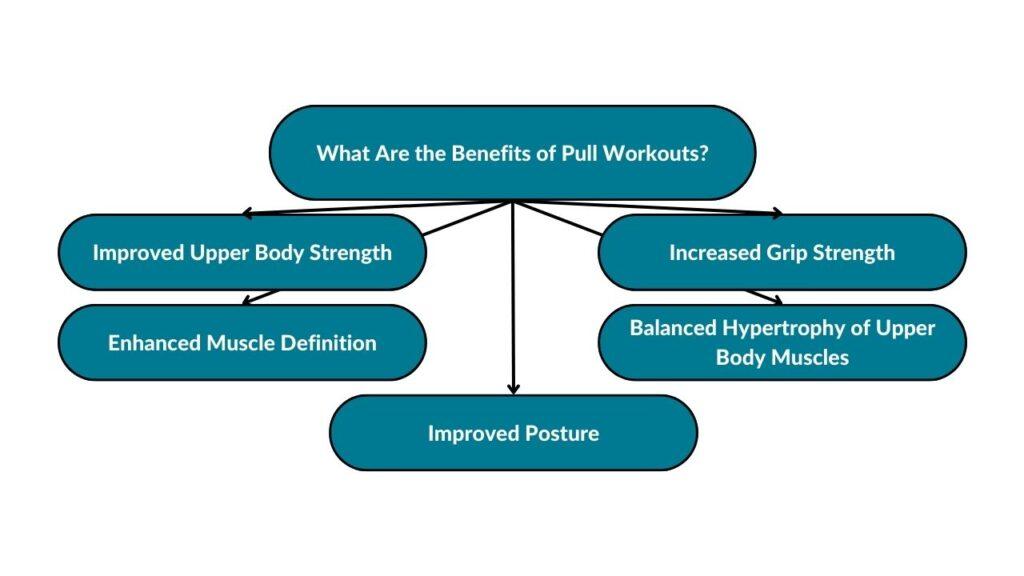
Let’s cover each of these a little more in-depth below.
Improved Upper Body Strength
Pull-day exercises such as rows and pull-ups will effectively improve your upper body strength. You will effectively increase the strength of upper body pulling muscles, and that will result in greater impact in the vertical and horizontal pulling movement pattern. A well-structured pull day gym session ensures you target all necessary muscle groups.
Enhanced Muscle Definition
Pulling workouts are excellent for enhancing your overall muscle definition. The muscles targeted and enhanced will include your lats, traps, rhomboids, posterior delts, erector spinae, and additional smaller back muscles.
Improved Posture
There is no better way to improve your posture than to strengthen those weak upper and lower back muscles. By performing horizontal rows, you will effectively strengthen scapular protractors, which are necessary to pull your shoulder blades back to achieve normal posture.
Rows of all pulling exercises are probably the best at correcting functional thoracic kyphosis.
Balanced Hypertrophy of Upper Body Muscles
There is no good posture and healthy body without having balanced muscles. As stated before, many of us, simply by our nature, have stronger pushing muscles, and that’s why most people nowadays suffer from excessive thoracic kyphosis.
Add to that new technology, smartphones, and laptops, and you also have problems with cervical lordosis. To minimize the negative effects of a modern lifestyle, one must regularly perform pulling exercises and workouts.
Increased Grip Strength
Holding equipment during your pulling workouts will effectively increase your grip strength.
One of the studies on the National Center for Biotechnology Information website titled “Grip Strength: An Indispensable Biomarker For Older Adults” suggests that grip strength is a useful indicator of overall health and a biomarker of health status [4].
This tells us that grip strength, more precisely, improvement in grip strength, can be seen as an effective measurement for assessing our lifespan and improving overall longevity.
FAQs
What Exercises Should I Start On Pull Day?
You should start with compound exercises on a pull day. It’s recommended to begin with compound exercises like pull-ups or bent-over rows, targeting the larger muscles of your back. These exercises set the foundation for your workout and help maximize muscle engagement before moving on to more isolated exercises like bicep curls.
Is a Bicep Curl Push or Pull?
A bicep curl is typically categorized as a “pull” exercise since it primarily involves the action of pulling a weight toward your body, engaging the bicep muscles in this pulling movement.
Why Push Day and Pull Day?
Push day and pull day are structured workouts that help ensure balanced muscle development and prevent overtraining by dividing exercises into movements that either push the weight away from the body or pull it toward the body, focusing on different muscle groups each day.
Is Deadlift a Pull or Leg?
The deadlift is primarily categorized as a “pull” exercise because it involves lifting a weight from the ground by pulling it upward, engaging the muscles of the back, particularly the lower back and the hamstrings, which are responsible for the pulling motion. However, it can also be categorized as a leg exercise since it involves muscles such as quads, hams, and glutes.
Are Skull Crushers Push or Pull?
Skull crushers are considered a “push” exercise as they involve extending your elbows to push the weight away from the body, primarily engaging the triceps during the extension phase.
How Important Is Pull Day?
Pull day is important in achieving a balanced physique and strength because it targets the muscles of the back, which are often underemphasized compared to the front of the body. Neglecting pull day can lead to muscle imbalances and potential injury.
Is It Ok to Combine Push and Pull Day?
Combining push and pull days into a single workout can be an effective way to achieve full-body training and save time. It allows for comprehensive training in both push and pull movements, but it can be physically demanding and time-consuming.
Can I Do Triceps on Pull Day?
Including triceps exercises on pull day is acceptable, especially if you’re following a push-pull workout split. However, it’s important to ensure a well-balanced routine by incorporating both push and pull movements.
What Happens if I Skip Pull Day?
Skipping pull day can lead to muscle imbalances and an overemphasis on the muscles used during push movements. Over time, this can affect your posture, strength, and overall fitness progress.
Is Pull Day Harder Than Push?
Whether pull day is harder than push day can vary depending on an individual’s strengths and weaknesses. Some people may find pull day more challenging due to the engagement of underworked muscles in the back, while others may struggle with push day exercises. It often depends on one’s fitness level and training history.
How Can I Get the Most Out of My Pull Day Workout?
Honestly, if you are a total beginner or even an intermediate lifter, there is a great chance you are going to make a lot of mistakes along the way.
You need to program your pulling workouts in a way that will satisfy the intensity, consistency, recovery, and many other things, and that’s something that many lifters struggle to do.
So, here is what I suggest.
Book a free consultation call with one of the Functional Body Savage coaches today, and let’s work together on achieving your deeply desired goals.
Start Building Your Dream Body Today
Ready to elevate your fitness game without falling into the trap of dull, repetitive routines that just don’t deliver? Imagine sculpting your ideal physique and boosting your health, all while still enjoying life’s pleasures, like those irresistible weekend getaways and your aunt’s legendary cheesecake. With our online fitness and nutrition coaching service, you don’t have to compromise. Dive into a personalized fitness journey that blends perfectly with your lifestyle, not against it. Book your completely free discovery consultation today, and take the first step towards a transformation that doesn’t require giving up the joys of life.

“I was skeptical about online fitness coaching, but Functional Body Savage completely changed my perspective. Vanja and Radomir’s personalized approach and attention to detail have helped me achieve goals I never thought possible. I’m stronger, more confident, and grateful for their guidance.”
Emily Thompson, San Francisco, CA
Learn More About Our Online Coaching ServiceReferences:
- Negrete RJ, Hanney WJ, Pabian P, Kolber MJ. Upper body push and pull strength ratio in recreationally active adults. Int J Sports Phys Ther. 2013;8(2):138-144.
- Fenwick CM, Brown SH, McGill SM. Comparison of different rowing exercises: trunk muscle activation and lumbar spine motion, load, and stiffness. J Strength Cond Res. 2009;23(2):350-358. doi:10.1519/JSC.0b013e3181942019
- Kreher JB, Schwartz JB. Overtraining syndrome: a practical guide. Sports Health. 2012;4(2):128-138. doi:10.1177/1941738111434406
- Bohannon RW. Grip Strength: An Indispensable Biomarker For Older Adults. Clin Interv Aging. 2019;14:1681-1691. Published 2019 Oct 1. doi:10.2147/CIA.S194543





